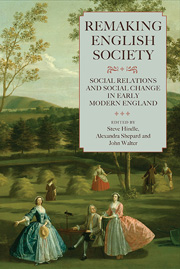Book contents
- Frontmatter
- Contents
- List of Illustrations, Figures, Maps and Tables
- Acknowledgements
- Notes on Contributors
- List of Abbreviations
- 1 The Making and Remaking of Early Modern English Social History
- 2 Brokering Fatherhood: Illegitimacy and Paternal Rights and Responsibilities in Early Modern England
- 3 Gender, Sexuality and the Consumption of Musical Culture in Eighteenth-Century London
- 4 Where was Mrs Turner? Governance and Gender in an Eighteenth-Century Village
- 5 Local Arithmetic: Information Cultures in Early Modern England
- 6 Intoxicants and the Early Modern City
- 7 Food, Drink and Social Distinction in Early Modern England
- 8 Written Obligations, Litigation and Neighbourliness, 1580–1680
- 9 Witchcraft and Neighbourliness in Early Modern England
- 10 Deference, Paternalism and Popular Memory in Early Modern England
- 11 Work, Reward and Labour Discipline in Late Seventeenth-Century England
- 12 Living in Poverty in Eighteenth-Century Terling
- 13 From Commonwealth to Public Opulence: The Redefinition of Wealth and Government in Early Modern Britain
- Appendix: Bibliography of the Published Writings of keith Wrightson from 1974 to 2011
- Index
- Tabula Gratulatoria
- STUDIES IN EARLY MODERN CULTURAL, POLITICAL AND SOCIAL HISTORY
12 - Living in Poverty in Eighteenth-Century Terling
Published online by Cambridge University Press: 05 May 2013
- Frontmatter
- Contents
- List of Illustrations, Figures, Maps and Tables
- Acknowledgements
- Notes on Contributors
- List of Abbreviations
- 1 The Making and Remaking of Early Modern English Social History
- 2 Brokering Fatherhood: Illegitimacy and Paternal Rights and Responsibilities in Early Modern England
- 3 Gender, Sexuality and the Consumption of Musical Culture in Eighteenth-Century London
- 4 Where was Mrs Turner? Governance and Gender in an Eighteenth-Century Village
- 5 Local Arithmetic: Information Cultures in Early Modern England
- 6 Intoxicants and the Early Modern City
- 7 Food, Drink and Social Distinction in Early Modern England
- 8 Written Obligations, Litigation and Neighbourliness, 1580–1680
- 9 Witchcraft and Neighbourliness in Early Modern England
- 10 Deference, Paternalism and Popular Memory in Early Modern England
- 11 Work, Reward and Labour Discipline in Late Seventeenth-Century England
- 12 Living in Poverty in Eighteenth-Century Terling
- 13 From Commonwealth to Public Opulence: The Redefinition of Wealth and Government in Early Modern Britain
- Appendix: Bibliography of the Published Writings of keith Wrightson from 1974 to 2011
- Index
- Tabula Gratulatoria
- STUDIES IN EARLY MODERN CULTURAL, POLITICAL AND SOCIAL HISTORY
Summary
Samuel Payne was baptised in the mid-Essex village of Terling on 1 August 1736, the fifth child of Robert and Mary Payne. After marrying in 1757 or 1758, he and his wife Sarah went on to have twelve children between 1759 and 1778, including (remarkably) three sets of twins: Hannah and Mary, baptised in June 1768, Joseph and John, baptised in June 1770, and Rhoda and Amelia, baptised in August 1773. This exceptional fertility left the Paynes heavily dependent on relief from the parish throughout the period. Samuel received relief during bouts of ‘sickness’ in each winter between 1767 and 1771, in the summer of 1773, the spring of 1776, and the late summer of 1781. Similarly, Sarah was incapacitated by her repeated pregnancies, requiring assistance in 1766, 1768, from March to December 1770, 1772 and 1773, and the summers of 1776 and 1778, coinciding with the birth of her last two children. By the time Samuel died, aged fifty-two, in January 1789, only nine of these children survived, but they and their mother continued to depend on occasional relief payments until at least 1801. Indeed, Sarah's son Robert followed his father, and his paternal grandfather and namesake, in sometimes requiring poor relief to support his family, as he struggled to make ends meet in the very difficult years at the turn of the nineteenth century.
- Type
- Chapter
- Information
- Remaking English SocietySocial Relations and Social Change in Early Modern England, pp. 281 - 316Publisher: Boydell & BrewerPrint publication year: 2013

